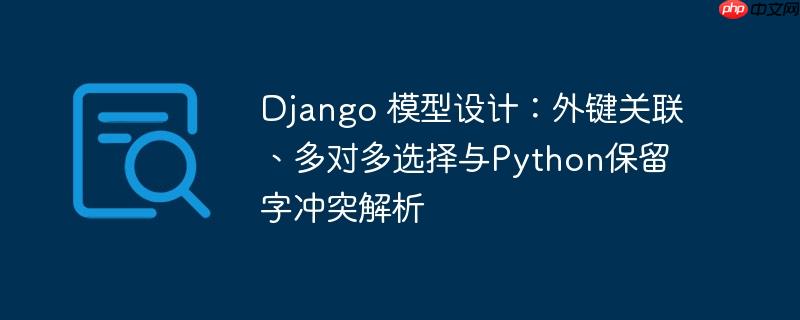
在django模型设计中,使用python的保留字作为模型字段名是一个常见的错误源。例如,type 是python中的一个内置函数和类型,用于获取对象的类型或动态创建类型。当您尝试在django模型中定义一个名为 type 的字段时,python解释器会将其误认为是内置的 type,从而导致 attributeerror 或其他不可预测的行为。
错误示例:
class Asset(models.Model):
# ...
type = models.ForeignKey(AssetType, on_delete=models.CASCADE) # 'type' 是Python保留字
# ...在上述代码中,type 字段的定义会导致问题。Python内置的 type 并不是一个模型字段的属性,因此当尝试访问 type.subtipos 时,会抛出 AttributeError: type object 'type' has no attribute 'subtipos'。即使不访问其子属性,仅仅将 type 作为字段名也极易引发混淆和潜在的冲突。
修正方法:
避免使用Python保留字作为字段名。通常,只需将字段名重命名为非保留字即可,例如将 type 改为 asset_type 或 tipo。
立即学习“Python免费学习笔记(深入)”;
另一个常见误区是尝试通过引用另一个模型实例的属性(特别是多对多关系管理器)来定义 ForeignKey。ForeignKey 字段必须指向一个完整的 Django 模型类,而不是一个模型实例的属性或一个关系管理器。
错误示例:
class Asset(models.Model):
# ...
tipo = models.ForeignKey(AssetType, on_delete=models.CASCADE)
subtipo = models.ForeignKey(tipo.subtipos, on_delete=models.CASCADE) # 错误:ForeignKey不能指向关系管理器
# ...这里的 tipo.subtipos 是一个 ManyToManyField 的关系管理器,它用于在 AssetType 的 实例 上查询和管理相关的 SubAssetType 对象。它本身不是一个模型类,因此不能作为 ForeignKey 的目标。ForeignKey 定义的是 Asset 模型与 SubAssetType 模型之间的一对多关系,意味着 Asset 的 subtipo 字段将存储一个 SubAssetType 对象的引用。
修正方法:
subtipo 字段应该直接关联到 SubAssetType 模型,因为它表示一个 Asset 实例与一个特定的 SubAssetType 实例之间的关系。
修正后的模型定义:
from django.db import models
class SubAssetType(models.Model):
name = models.CharField(max_length=50)
slug = models.SlugField(unique=True) # 建议添加唯一性约束
descripcion = models.TextField(null=True, blank=True)
def __str__(self):
return self.name
class AssetType(models.Model):
name = models.CharField(max_length=50)
slug = models.SlugField(unique=True) # 建议添加唯一性约束
descripcion = models.TextField(null=True, blank=True)
subtipos = models.ManyToManyField(SubAssetType, blank=True)
def __str__(self):
return self.name
class Asset(models.Model):
# Atributos nominales
name = models.CharField(max_length=50)
slug = models.SlugField(unique=True) # 建议添加唯一性约束
descripcion = models.TextField(null=True, blank=True)
# Atributos de valor
tipo = models.ForeignKey(AssetType, on_delete=models.CASCADE, related_name='assets') # 将'type'改为'tipo'
subtipo = models.ForeignKey(SubAssetType, on_delete=models.CASCADE, related_name='assets_of_subtypes') # 直接关联SubAssetType
def __str__(self):
return f"{self.name} ({self.tipo.name} - {self.subtipo.name})"修正后的模型定义解决了语法错误,但并未强制 Asset 的 subtipo 必须是其 tipo 所属的 subtipos 之一。这种复杂的业务逻辑约束不应在模型字段定义中直接实现,因为模型定义主要关注数据结构和基本关系。此类约束应在应用层(例如 Django 表单、自定义验证器或视图逻辑)进行处理。
示例:在 Django 表单中实现业务逻辑约束
通过在表单的 __init__ 方法中动态调整 subtipo 字段的查询集(queryset),并在 clean 方法中添加自定义验证逻辑,可以实现这种约束。
# forms.py
from django import forms
from .models import Asset, AssetType, SubAssetType
class AssetForm(forms.ModelForm):
class Meta:
model = Asset
fields = '__all__'
def __init__(self, *args, **kwargs):
super().__init__(*args, **kwargs)
# 动态过滤 subtipo 的选项
# 如果是编辑现有 Asset,或者表单已经绑定了数据且包含 'tipo'
if self.instance.pk and self.instance.tipo:
# 编辑模式下,根据已选择的tipo过滤subtipo
self.fields['subtipo'].queryset = self.instance.tipo.subtipos.all()
elif 'tipo' in self.initial:
# 新建模式下,如果通过 initial 数据预设了 tipo
try:
asset_type = AssetType.objects.get(pk=self.initial['tipo'])
self.fields['subtipo'].queryset = asset_type.subtipos.all()
except AssetType.DoesNotExist:
# 处理初始 tipo 不存在的情况
self.fields['subtipo'].queryset = SubAssetType.objects.none()
else:
# 默认情况下,subtipo 字段可能为空或显示所有 SubAssetType
# 也可以在这里设置一个空的 queryset,等待 tipo 选择后通过 JS 动态更新
self.fields['subtipo'].queryset = SubAssetType.objects.none() # 默认不显示任何选项,等待 tipo 选择
def clean(self):
cleaned_data = super().clean()
tipo = cleaned_data.get('tipo')
subtipo = cleaned_data.get('subtipo')
if tipo and subtipo:
# 检查选定的 subtipo 是否属于选定的 tipo 的 subtipos
if not tipo.subtipos.filter(pk=subtipo.pk).exists():
raise forms.ValidationError(
"选择的子类型不属于当前资产类型允许的子类型范围。"
)
elif tipo and not subtipo:
# 如果 tipo 选择了但 subtipo 未选择,且 tipo 必须有 subtipo
# 可以在此处添加逻辑,例如:
# if tipo.subtipos.exists(): # 如果该 tipo 确实有可选的 subtipo
# raise forms.ValidationError("请为该资产类型选择一个子类型。")
pass # 否则,如果允许没有 subtipo,则无需额外验证
return cleaned_data
注意事项:
在Django模型设计中,清晰地理解Python保留字的使用限制以及 ForeignKey 和 ManyToManyField 的工作原理至关重要。将 type 等保留字重命名,并确保 ForeignKey 正确地指向模型类,是解决基本语法错误的关键。更重要的是,对于依赖于其他字段值的复杂业务逻辑约束,应将其从模型定义中分离出来,并在Django表单或自定义验证器中实现,以确保数据的一致性和用户体验。这种分层处理数据结构和业务逻辑的方法,是构建健壮、可维护Django应用的最佳实践。
以上就是Django 模型设计:外键关联、多对多选择与Python保留字冲突解析的详细内容,更多请关注php中文网其它相关文章!

每个人都需要一台速度更快、更稳定的 PC。随着时间的推移,垃圾文件、旧注册表数据和不必要的后台进程会占用资源并降低性能。幸运的是,许多工具可以让 Windows 保持平稳运行。

Copyright 2014-2025 //m.sbmmt.com/ All Rights Reserved | php.cn | 湘ICP备2023035733号